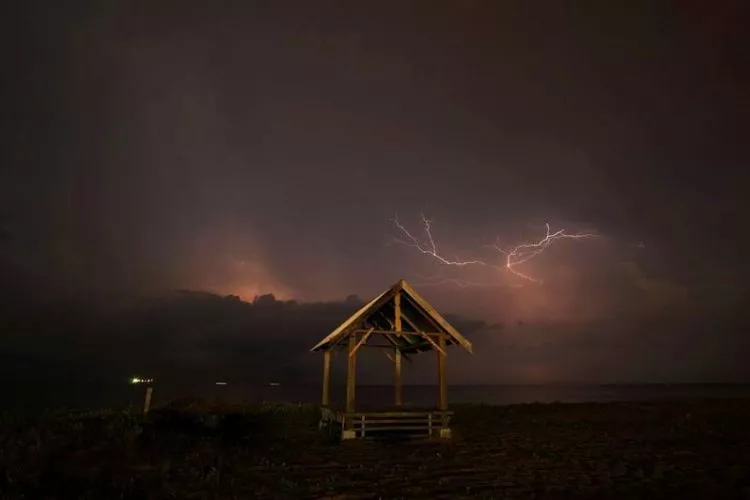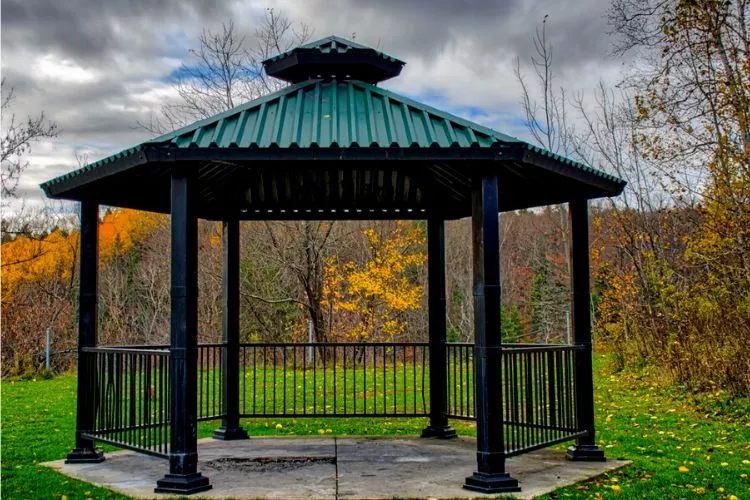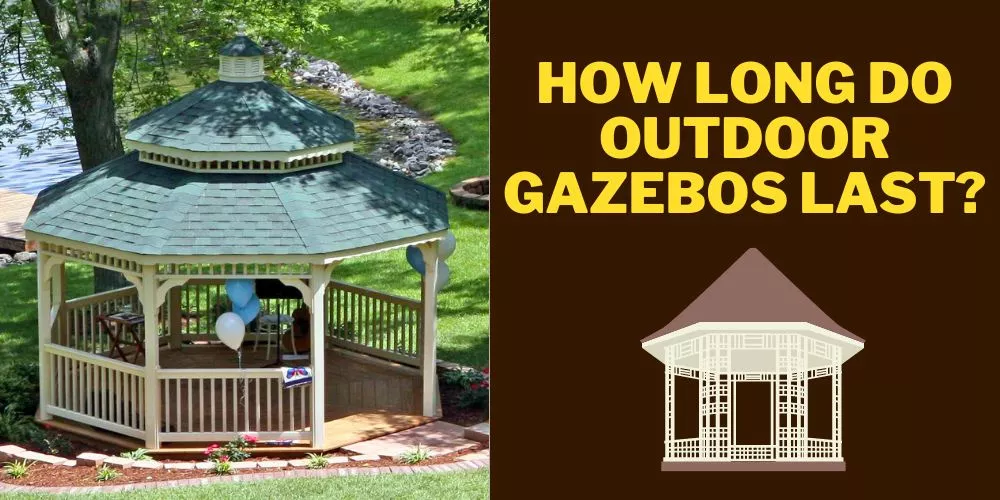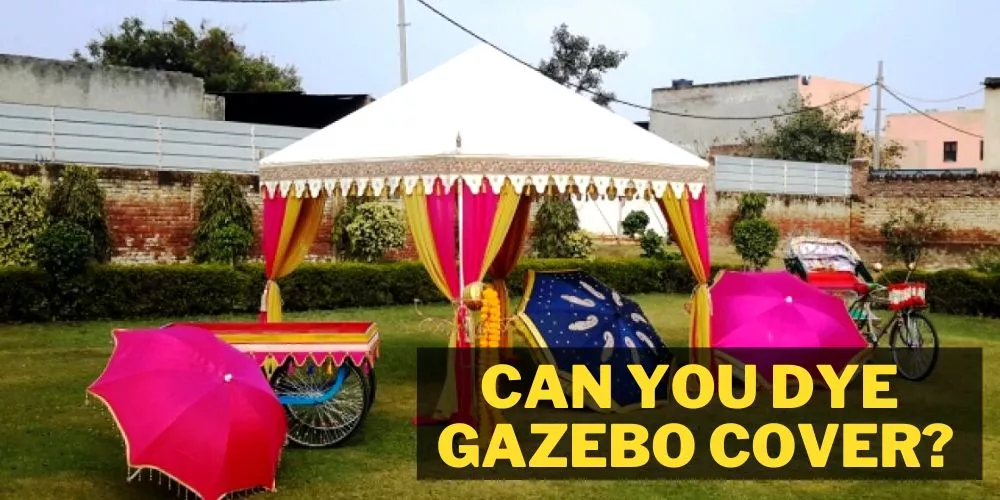When thunderstorms are present, lightning is always possible to follow soon after. It’s impossible to say that certain structures are 100% guaranteed safe from lightning. However, some places are safer than others. These include larger buildings with heavy pipework and cables that can help ground the lightning. So, are gazebos safe In lightning?
Well, gazebo generally doesn’t fare too well, especially those constructed using metal. The unique shape can act as a cage, which distributes the shocks and damages throughout the structure. In this article, we’ll go through why a gazebo isn’t safe during lightning. We will also look at how to improve the chances of a gazebo’s survival when exposed to such weather.

Are gazebos safe in lightning?
Lighting isn’t picky when it comes to striking. It can affect any structure as it bolts toward the earth’s surface. The higher the structure, the more likely it will get hit. Being out in the open will also increase the chances of becoming affected by a bolt. Gazebos are not excluded from the long list of lightning targets.
They are usually constructed using conductive materials such as metals, aluminum, copper, and steel. These structures can be grounded to help dampen the impact, but even then, they are not 100% guaranteed to be any safer. Gazebos are not a place that is recommended to hide out in when a lightning storm is present.
Do Metal Gazebos Attract Lightning?
There is a lot of debate surrounding whether or not metals attract lightning. The reality is, though, that lightning isn’t attracted to anything. The governing factors that control a lightning bolt’s path include height and isolation. For example, taller structures, such as bridges or buildings, trees, power poles, etc., are more susceptible to lightning effects.

Even more so when these things are in the middle of nowhere. When lightning strikes, it heads directly for the ground and uses whatever is in its path as a conduit. So it’s safe to say that when it comes to gazebos, regardless of their construction materials, they don’t attract lightning. However, if they are the only structure in an open area, they may be in the line of fire.
Additionally, standing in a metal gazebo may be slightly more dangerous as it would act as a live cage. You would be severely injured if you touched any metal parts. Timber models may burn or explode on impact depending on the gauge and strength of the material.
Should a Metal Gazebo Be Grounded?
Regardless of the material used to build or erect a gazebo, they should all contain some grounding or ‘earthing’ rod. Of course, lightning storms aren’t the first thing on your mind when you set your gazebo up at the beach or on a camping trip, but we’ll get to that.

What are grounding rods made from?
Grounding rods are fabricated using highly conductive metals. The most common metals are solid copper, copper-bonded steel, stainless steel, and galvanized steel. They are usually attached to the structure via a tailing insulated cable and buried deep into the nearby soil.
Grounding rods are not only restricted to gazebos, though; most structures have their method of ‘earthing.’ They are set up to protect against overcurrent related damages to the electrical system caused by lightning strikes.
How do grounding rods work?
These rods allow the lightning strike to discharge into the earth. The lightning hits the object or structure at its highest point and continues through it via the piping, cable system, or other conductive materials. As it reaches the base of the structure, it can electrify the ground or continue through the cable.
Lastly, it can freely discharge through the rod deep into the ground. If lightning hits the ground, it electrifies the dirt, clay, sand, etc., and turns them into silicas. Once the frying is complete, the ground becomes more of a glassy rock and is shaped like a corrugated tube.
How are grounding rods installed?
This safety measure is much easier to install on a permanently built variant than a pop-up style gazebo. Permanently built gazebos can have the cable added to the ground much earlier in the project. They are then filled over then simply attached once the gazebo is complete.
Whereas pop-up gazebos rarely come with a grounding rod in their packaging, most users wouldn’t even entertain using them. You can purchase one, but you generally don’t go on your outdoor adventure with your gazebo and expect to get stuck in a lightning storm.
How to ground a metal gazebo?
Grounding a metal gazebo is important to provide stability for the structure and safety during inclement weather, particularly when dealing with electricity. In scenarios where your gazebo is fitted with electronic appliances such as fans or decorative lights, a robust grounding system is essential to divert electric shocks to the ground and prevent potential hazards. Below is a comprehensive step-by-step guide on how to ground a metal gazebo:
Requirements
Before getting started, you will need the following materials:
- Metal rod – anything between 7-8 feet long
- Cooper wiring – 14-gauge wire is recommended
- Wire clamps
- Shovel
- Wire strippers
- Electrical Tape
- Hammer
Step 1: Choose the Grounding Rod Location
Choose a spot close to your gazebo, usually within a few feet, where you can drive the metal rod into the ground. This should be a spot that is convenient to run the wire from the gazebo to the grounding rod but also in a safe, unobtrusive location.
Step 2: Drive the Grounding Rod Into the Ground
Use your shovel to dig a hole about 2 feet deep. Then, position your metal rod in the hole. Hammer the rod into the earth until it’s at least 6 feet deep into the ground. About 1-2 feet of rod should remain above ground level.
Step 3: Attach Copper Wire to The Gazebo
Choose a strategic point on your metal gazebo structure, usually at the base or a leg, to attach your copper wire. You can do this by wrapping around the wire and securely fastening it with a wire clamp.
Step 4: Run the Wire to the Grounding Rod
Run the wire from the attachment point on the gazebo to the grounding rod. Try to run the wire in a secure and discreet manner, ensuring that it poses no potential trip hazard.
Step 5: Attach the Wire to the Grounding Rod
Strip the end of your copper wire with wire strippers. Once exposed, wrap the wire tightly around your grounding rod. Use a wire clamp to ensure it’s secure. Cover it using electrical tape to prevent corrosion due to exposure to elements.
Step 6: Check Your Work
At this point, your metal gazebo should now be grounded. Check that the copper wire is securely attached to both the gazebo and the grounding rod.
Additional Safety Tips:
- Always switch off your electrical appliances before it rains heavily
- Avoid setting up your gazebo near water sources like swimming pools, ponds, or bird baths to prevent electrical hazards
With this guide, you can safely ground your metal gazebo and ensure it’s stable and safe to use in all seasons. During the installation process always prioritize your safety and if you don’t feel comfortable, don’t hesitate to contact a trained professional to help with grounding your metal gazebo.
Benefits of Grounding a Metal Gazebo
They say that ‘lightning doesn’t strike the same place twice.’ As much as we believe this to be true, it’s not worth taking the risk. Especially when it comes to the mother of all conductive gazebos, the metal variant, just one lightning strike can cause extreme damage to its target area.

This includes starting fires, setting off explosions when striking combustible items, and also structural damage from warping. And that’s just material damage. Getting struck by a lightning bolt or being surrounded by a high voltage cage can cause serious injury and even be fatal. Therefore grounding a metal gazebo provides an added level of safety.
Additionally, some insurance companies won’t cover the damages caused by lightning storms if there hasn’t been a grounding rod installed. This is not always the case, but it’s recommended to check that out in your insurance policy when building and securing a metal gazebo. Another benefit of adding a grounding rod is minimizing the damage caused to surrounding structures.
You May Also Find Useful: Are Gazebos Waterproof? | Can You Grill Under A Gazebo?
Frequently Asked Questions (FAQs)
Can you use plastic stakes to ground a gazebo?
Plastic is an insulator. It doesn’t allow electrical currents to flow as fast or smoothly as metals. So, they can be used, but they are not the best choice when risking lives and belongings against lightning. On the other hand, metals such as solid copper, copper-bonded steel, stainless steel, or galvanized steel are conductors. They are best for guiding discharge into the ground.
Can you use a gazebo in a thunderstorm?
You can use a gazebo in any weather at your own risk. The amount of damage that may be caused is generally governed by the strength and stability of the gazebo. Furthermore, some thunderstorms belt down with rain; some have lightning, and others are quite tame. There are many variables to think about when coming to this conclusion. It’s always recommended to research the weather conditions and their severity before using outdoor structures such as gazebos.
Can you get struck by lightning in a gazebo?
Gazebos aren’t built to protect from any kind of weather. They are structures of beauty and ambiance. Therefore, they can be struck by lightning. Lightning isn’t attracted to anything in particular. Its bolts are governed by height and isolation. So if a gazebo is built or erected in an area higher than other structures or trees or even in the middle of nowhere, it will be more prone to lightning.
Conclusion:
Gazebos aren’t lightning proof; they aren’t even structures guaranteed to protect from heavy rains. Therefore it’s fair to say that they aren’t safe from lightning. However, they can be slightly improved by adding grounding rods. The safest gazebos are built with timber as they are more insulators. The most lightning prone materials are metals, as they are conductors. It’s best to stay out of a gazebo during a lightning storm. We hope that this guide has been helpful. You can read about similar topics here on our website. Check back again soon for more.


